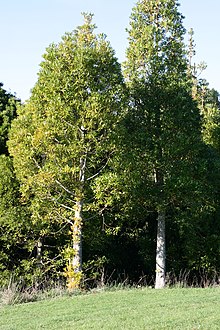Agathis macrophylla
| Agathis macrophylla | |
|---|---|

| |
| Young trees at Auckland, New Zealand | |
| Scientific classification | |
| Kingdom: | Plantae |
| Clade: | Tracheophytes |
| Clade: | Gymnospermae |
| Division: | Pinophyta |
| Class: | Pinopsida |
| Order: | Araucariales
|
| Family: | Araucariaceae |
| Genus: | Agathis |
| Species: | A. macrophylla
|
| Binomial name | |
| Agathis macrophylla | |
| Synonyms[2] | |
| |
Agathis macrophylla known as Pacific kauri, is a
Description
The
Male
Ecology

A. macrophylla is one of the largest trees in its range, and occurs as a dominant emergent tree in closed, humid, lowland-montane tropical forests. Associated plant species vary from location to location, but include Cryptocarya turbinata, Ilex vitiensis, Garcinia vitiensis, Palaquium spp., and Podocarpus spp. in Vanuatu, Calophyllum vitiense, Dacrydium nidulum, Retrophyllum vitiense, Fagraea berteroana, and Podocarpus spp. in Fiji.
It is one of the fastest growing species in its genus, capable of growing 1-1.5 metres in height annually in lightly shaded to open areas, where growth is fastest. The species is fairly shade tolerant, especially in the seedling stage, though growth is slow under suppression. Strong root systems enable mature trees to withstand cyclones and seed rapidly into gaps. The species on the whole is long lived, capable of reaching ages of 300–1000 years.
Uses
A. macrophylla is a valued commercial timber species, and its wood is much sought after for many uses. The wood is a cream to gold colour (mature
Pacific kauri is a valuable tree throughout the southeastern Pacific (Melanesia). The timber is frequently used for house construction, canoe carving, and totem pole construction. Smoke from the resin is used as a black dye for hair, clothes and tattoos, and the leaves are used in traditional medicine. Fijians value the resin itself (known as makadre) to be used as pottery glaze and torch fuel.[4]
See also
- Agathis australis, New Zealand kauri
References
- . Retrieved 12 November 2021.
- ^ Agathis macrophylla (Lindl.) Mast. Plants of the World Online. Retrieved 7 January 2024.
- ^ Agathis macrophylla was previously known as A. obtusa in Vanuatu and A. vitiensis in Fiji, but these are now regarded as 'non-preferred names' (Thompson 2006:2).
- ^ Keppel, Gunnar; Ghazanfar, Shahina A. (2011). Trees of Fiji: A Guide to 100 Rainforest Trees (third, revised ed.). Secretariat of the Pacific Community & Deutsche Gesellschaft für Technische Zusammenarbeit. pp. 54–5.
Notes
- Lex J. Thompson (2006). "Agathis macrophylla (Pacific kauri), ver. 1.2" (PDF). Species Profiles for Pacific Island Agroforestry. Edited by C.R. Elevitch. Permanent Agricultural Resources (PAR) Holualoa, Hawaii. Archived (PDF) from the original on 24 July 2007. Retrieved 2007-08-07.
- R. Thaman; C.R. Elevitch; K.M. Wilkinson, eds. (2000). "Multipurpose trees for agroforestry in the Pacific islands" (PDF). Agroforestry Guides for Pacific islands #2. Permanent Agricultural Resources (PAR) Holualoa, Hawaii. Retrieved 2007-08-10.
External links
- Agathis macrophylla at the Gymnosperm Database.

